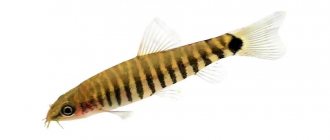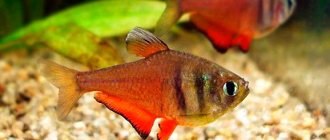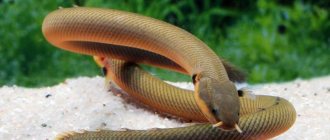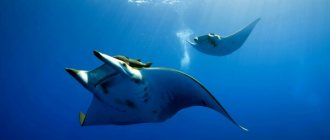The variety of aquarium fish is sometimes amazing. And taking into account the fact that one type of fish has its own varieties, the aquarium world becomes simply gigantic.
swordtails , even those who have never even seen aquariums. We can say that swordtails, the fish of all children of the Soviet Union, were in all Soviet aquariums. The fish is very beautiful and unpretentious.
Such popularity has led to the fact that swordtails have undergone serious breeding work aimed at obtaining various color morphs through hybridization. Morphs, in turn, actually drove all natural swordtail species out of the market.
Compatibility of Swordtails
Swordtails are non-aggressive. They are compatible with almost all small peaceful fish. Among the best neighbors are tetras , minors , thornets , zebrafish , all poeciliid fish , etc. They are compatible with almost all bottom fish: corydoras , acanthophthalmus , platidoras , ancistrus , etc. They get along well with “peaceful” cichlids, for example, with angelfish .
Swordtail Kohaku photo
Swordtails are incompatible with aggressive and large fish that will hunt them, for example, cichlids (acaras, astronotuses, diamond cichlids, etc.). In addition, it is not recommended to add them to “veiled” fish, because the latter are slow and swordtails can “pinch” them by their fluttering fins.
Male swordtails show some intolerance and aggression towards each other. There have been cases of males fighting, even to the point of causing damage to each other. Therefore, in an aquarium, swordtails should be kept in a harem, so that there are 2-3 females per male. In this case, the intraspecific aggressiveness of the fish is noticeably reduced. See the article on aquarium fish compatibility.
Koromo
Koromo means "mantle". The color pattern is characterized by a pattern of red dots (hi) outlined in dark tones. Ai goromo - a kohaku whose scales have blue borders; Sumi goromo has a black body background with hi markings; Budo goromo has a sumi covered with hi markings. This pattern creates a purple/rich red-brown coloration.
Koromo breed: Ai, Sumi, Budo.
Minimum aquarium volume for swordtails
Many novice aquarists keep swordtails in small aquariums. However, this is not entirely correct. In fact, swordtails are quite large fish. And taking into account the fact that it is recommended to keep swordtails in the proportion of 1 male to 2-3 or more females, the minimum size of the aquarium for them should be from 50 liters per harem family. The aquarium for swordtails should be spacious, it is better to take 100 liters.
Find out how many fish you can keep in X liters of aquarium HERE (at the bottom of the article there are links to aquariums of all sizes).
Price
The price for representatives of the Kohaku morph of koi depends on their age, gender, coloring characteristics and purity of the line. The average cost of fry is 50 rubles, teenagers - 100-150 rubles, adult fish - 200 rubles. At the same time, the most contrasting and symmetrically colored fish will cost more. Linear bred swordtails, which do not carry extra “junk” genes, are valued more highly than individuals obtained by randomly crossing fish of different morphs.
Koi Kohaku is an unusual morph that stands out from the background of other inhabitants of the aquarium and attracts the attention of the observer with its bright contrasting color. Keeping these fish is not particularly difficult and is no different from keeping swordtails of other morphs. Despite the fact that this morph is not very common in hobbyist aquariums, its price is relatively low, which makes Santa Claus swordtails accessible even to beginners.
If you liked the article, leave comments and share a link to it on social networks.
Care requirements and conditions for keeping swordtails
Swordtails do not need any special conditions. In fact, maintaining optimal aquarium water parameters is the key to their well-being. However, do not forget that:
1. Swordtails definitely need aeration and filtration, weekly replacement of up to 1/4 of the volume of aquarium water. It is worth noting that these fish do not need a lot of oxygen, and too frequent changes (replacement) of aquarium water are not as beneficial for them as for other types of aquarium fish. Therefore, if you change the water less often, for example, once every 14 days, and not every 7, nothing bad will happen. This rule is appropriate with a stable biobalance and zero nitrogen: NH4, NO2, NO3. As with any other fish, high concentrations of poisons are unacceptable: ammonia, nitrites and nitrates . Every conscientious aquarist should always have a set of drop tests on hand, at least for nitrate and phosphate. Fortunately, they have now become inexpensive, there are no problems with their assortment and acquisition. For example, we can with a clear conscience recommend you the cool UHE drop tests, , but they are sold only online. In stores in your city - offline, you can find inexpensive Vladox tests . Friends, watch out for nitrogen compounds, keep them in check and everything will be fine for you and your pets.
It would be useful to use clean water supply for deep water changes and use preparations that neutralize harmful substances. For example, Tetra AquaSafe - it removes chlorine compounds, heavy metals + contains B vitamins, iodine and other aquarium goodies.
Swordtail Kohaku photo
2. The aquarium must be covered with a lid, because The fish are nimble and can jump out and die.
3. Like many fish, swordtails feel comfortable among vegetation. Vallisneria , Echinodorus , Cryptocoryne , Riccia , duckweed as aquarium plants for them . Creating thickets of plants imitates the natural habitat of fish.
4. When decorating an aquarium, it is necessary to organize an open space for swimming. Swordtails are excellent swimmers. Swordtails do not need shelter at all.
Utsurimono
Representatives of this variation are often confused with Bekko. However, Utsurimono koi are predominantly black in color with white, red and yellow markings.
Shiro utsuri – black koi with white markings; Hi utsuri – black koi with red markings; Ki utsuri - black koi with yellow markings (rare variation).
Utsurimono breed: Hi, Ki, Shiro.
Feeding and diet of swordtails
Swordtails are unpretentious in food, they are omnivores and prone to overeating. They enjoy eating dry and freeze-dried food: flakes, granules, chips. You can easily use Tetramine as a base feed. And additionally feed containing carotenoids.
Allow me to make a small note. Color series food - enhances the natural color of fish (red, yellow colors), as it is enriched with pigments such as canthaxanthin, astaxanthin . In fact, carotenoids are natural “coloring” substances. It is astaxanthin that gives plants their red-orange color, carrots are a prime example of this. Or, for example, have you ever wondered why flamingos are pink? Yes, that's exactly why. By eating plant and animal foods rich in carotenoids, the flamingo's plumage, which is initially white, gradually turns pink. The more birds receive this substance from food, the richer and redder the plumage becomes. If you look even deeper, flamingos eat the well-known brine shrimp - pink, saltwater crustaceans and also turn pink.
Actually, the same thing happens to fish if the food contains carotenoids. We also note that astaxanthin also has other beneficial properties - it is also an antioxidant. In general, we can say that carotenoids are beneficial not only for fish, but also for all aquatic organisms, even aquarium plants. The only thing is that everything should be in moderation and balanced. You need to understand that the color of the fish also depends on the state of health, environment, life circumstances (stress/spawning) and the characteristics of the aquarium lighting.
Actually, to summarize, the Color series food is good, but should not be a basic diet. Imagine what will happen to a person who eats only one beet all week =) It’s scary to imagine. The same goes for the fish... sorry, they start pooping cute pink poop.
In this matter, by the way, it is very important not to overfeed the fish, so as not to run into problems with the gastrointestinal tract. Feed the swords once a day, do fasting days. This will be one of the keys to success in their maintenance. It should be noted that when purchasing any dry food, you should pay attention to the date of its manufacture and shelf life, try not to buy food in bulk, and also store the food in a closed state - this will help to avoid the development of pathogenic flora in it.
Interesting facts about koi carp
It is believed that carps were brought to China about 2 and a half thousand years ago from the territory adjacent to the Caspian Sea. After this, immigrants from China brought carp to Japan, after which the Japanese began to call the carp “black” carp. It is not known exactly when carp appeared in Japan, but the first written memories of this appeared in the 14th-15th centuries AD. Peasants began to raise carp artificially in special reservoirs in order to have food. This was especially true for residents of remote mountainous areas, who were often cut off from civilization for a long time. In this case, carp served as the only source of protein food.
Over a long period of time, natural mutations began to appear, which led to the appearance of fish with non-standard body coloring. The Japanese did not eat such fish, but kept them purely “for the soul,” as they say. After some time, the peasants began to get involved in breeding colored carps. As a result of crossing fish from different hosts, individuals with unique colors began to appear. This hobby quickly spread throughout Japan and occupied the minds of not only ordinary peasants, but also merchants, as well as other nobility.
Huge KOI carp caught in the river. Video. Photo. | King KOI
Reproduction and breeding of Kohaku swordtails
Breeding and propagating swordtails is absolutely not a difficult task. It is similar to the reproduction of guppies and other livebearers . And, one might say, it actually happens on its own.
Sexual maturity in swordtails occurs at the age of 5-6 months. For breeding (and for their own comfort), it is recommended to keep fish in a ratio of one male to three females. In the process of courting a female, the male performs a kind of courtship dance - shuttle movements back and forth.
Fertilization of mature eggs occurs inside the female. This process may take several days. An interesting feature is that a once fertilized female swordtail can give birth to offspring several more times, even in the absence of a male.
The duration of a female's pregnancy is 4-6 weeks. This period depends on the parameters of the aquarium water, temperature, lighting and feeding.
The pregnant female has a full abdomen and a "black pregnancy spot" under her tail. It is believed that a few hours before the “birth” the female’s belly becomes “square”, the female begins to move more actively, “throwing” up and down along the aquarium glass.
At one time, the female spawns from 15 to 100 or more fry. Spawning usually occurs in the morning.
With plenty of nutrition and a water temperature of 26-27° C, birth can occur monthly.
Perhaps the most important rule to follow when breeding swordtails is concern for the survival of the young. Unfortunately, the producers eat their own offspring, and given that the fry of swordtails are quite large in size and brightly colored, this process simply turns into extermination. In nature, swordtails never see their offspring, because... The fry is immediately carried away by the current. In the aquarium, the parents mistake the fry for food.
To preserve the offspring, I plant the aquarium densely with aquarium plants. Plants are placed at the bottom of the aquarium, in the water column and especially densely on the surface. Thus, the fry are provided with shelter “from evil parents” and most of the fry survive.
Also, to preserve the offspring, you can use special aquariums, which are designed like a funnel - the female remains in the funnel, and the swept juveniles fall out of the funnel into the spawning aquarium. Thus, initially the absence of contact between the breeder and the fry is ensured.
The third option for preserving offspring is spawning spawners immediately after spawning. This option is simple, but requires attention and timeliness from the aquarist.
Photo of a pregnant female swordtail, here she is giving birth
Deeply pregnant female swordtail =)
After spawning, the female is removed and provided with abundant feeding.
The initial food for juvenile swordtails is live dust (nauplii, brine shrimp, cyclops, microworm, rotifers, cut tubifex).
After a week, the juvenile swordtails begin to be weeded out - divided into strong and “thoroughbred” ones, and the weak and defective ones are destroyed.
The juveniles grow quickly; after two months, the anal fin of the males begins to change, and by the third month the “sword” begins to grow.
When keeping swordtails of different species, independent crossing occurs, as a result of which you can sometimes get beautiful offspring.
An interesting fact from the life of these fish is that the female swordtail can at some point become a male, i.e. change gender This occurs under conditions of a “shortage” of males and is explained by the struggle for the survival of the species. The offspring of a female + former female pair consists of almost 90% females.
Description
Koi Kohaku swordtails have a characteristic, memorable coloration that combines two colors: red-orange and white. Usually the head and back to the base of the dorsal fin, as well as the tail, are colored red-orange. The middle part of the body is white. Colored spots can be of different shapes and sizes; sometimes they extend onto the fins, coloring them in the same bright shade. Most often the fins remain white. Kohaku koi fish lack black pigment, which is why the pupil is red; The iris of the eye is usually white.
The shape and size of the body and fins of fish of this morph are the same as those of the standard swordtail. In males, on the caudal fin there is a xiphoid outgrowth formed by elongated lower rays.
Diseases and treatment of swordtails
Swordtails are very resilient fish and can withstand harsh conditions. However, like all living beings, such excellent health does not last forever. The key to successfully keeping fish is to ensure optimal aquarium water conditions.
Swordtails are susceptible to all the typical diseases of aquarium fish and there are no nuances in their treatment.
For proper and correct treatment of swordtails, it is necessary to diagnose the disease, and then apply the necessary procedures. Treatment and diseases of aquarium fish and sections of the site will help you with this FISH DISEASES, AQUA.MEDICINE.
What do fish look like?
The habitat of swordtails is the shallow waters of Mexico and Honduras. He likes to live in thickets of grass - there is a higher probability of feeding on insects. Since in nature this fish is accustomed to feeding on small food from the surface, its mouth is positioned accordingly: raised up. Otherwise, the fish has a classic body shape with average fins. Only the lower ray of the tail is so elongated that it is shaped like a sword. This makes the fish unique. The tail sword gave the fish its name in both Russian and Latin.
The size is not as small as we are used to seeing: it can reach 10 cm in length, not counting the sword. When it comes to color, there is a lot more variation than just bright red.
Hikari - Utsurimono
This group of koi is represented by variations of the seam and utsuri with a metallic sheen. Kin showa has a golden sheen, while gin showa has a silvery sheen; Gin shiro - similar to the shiro utsuri variation, but with a metallic tint; Kin ki utsuri – yellow utsuri with a metallic sheen; Kin hi utsuri – red utsuri with a metallic sheen;
Hikari breed - Utsurimono: Kin Showa, Kin Hi Utsuri, Kin Ki Utsuri, Gin Shiro.











